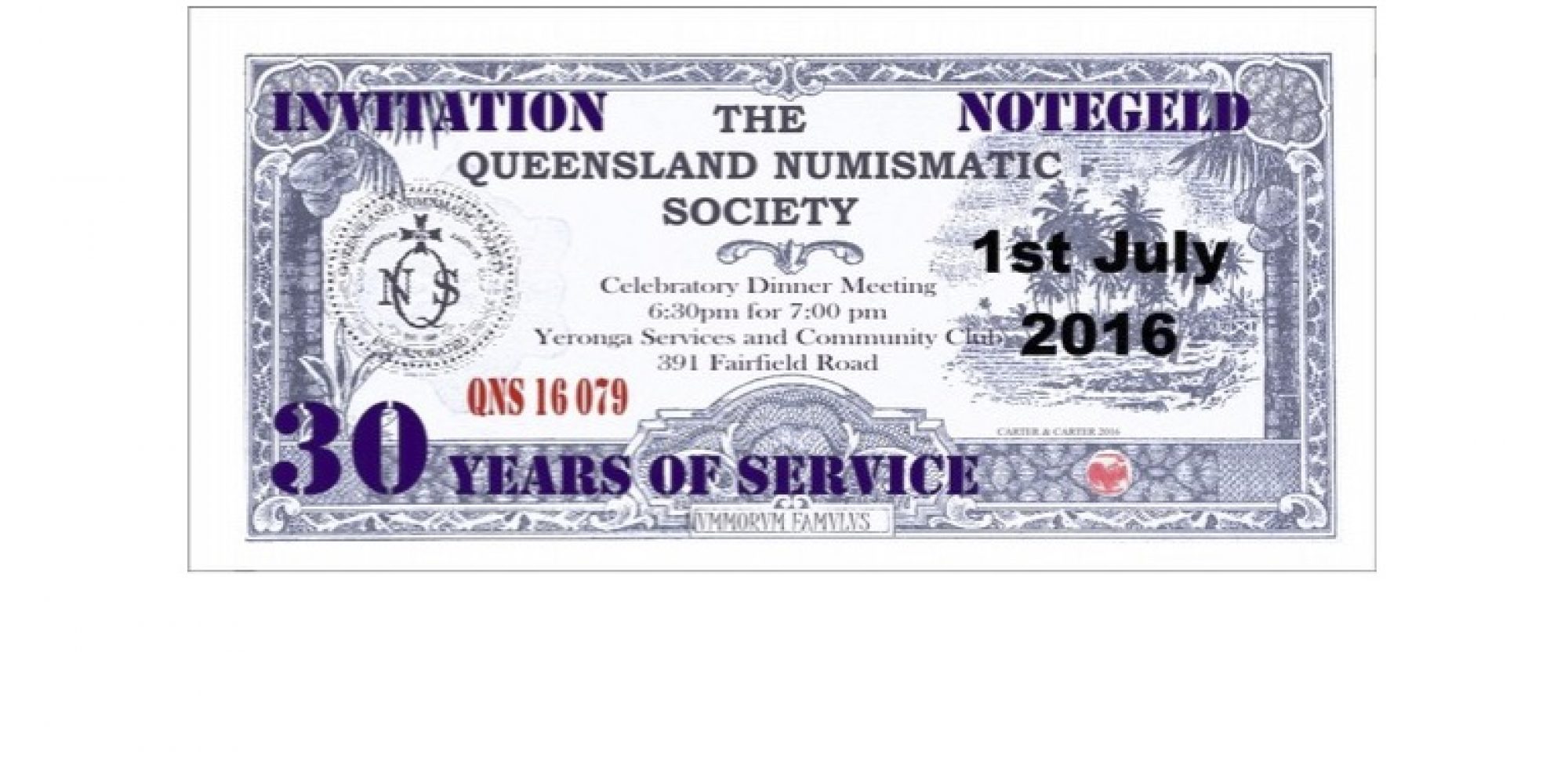by Stephen Appleton
In philately, they are called ‘cinderella countries’, but I’m not sure if that’s the correct numismatic term. And just in case there are any sympathisers among the Magazine’s readership, I have chosen to be politically correct with my title. But, what is diplomatically-challenged coinage (DCC), exactly?
There are, throughout the world, coin issuing ‘authorities’, which, for one reason or another, are not recognised as legitimate countries. Some, such as Somaliland (northern Somalia), Transnistria (eastern Moldova) and Anguilla (British Caribbean Territories) had or have achieved all the appearances of being ‘real’ countries and were welcomed and recognised by a majority of the local population. They were or are only lacking in official diplomatic recognition by the rest of the world.
Others, however, have more of a ‘wishful thinking’ aspect to their existence. It is these latter entities which this article will focus on. Collectors of coins from ‘nations’ such as those mentioned below usually find themselves reaching for the ‘Krause Catalogue of Unusual World Coins’ rather than the Standard Catalogue.
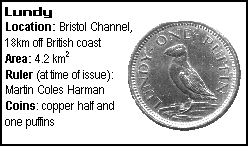 Lundy is the most famous example, largely because it was one of the earliest. In 1929 the island’s owner, Martin Coles Harman, elected to issue his own coins for use there. The British government objected to this and the rest is numismatic history. Of all the coins in this article these are the only ones you’re likely to find in circulated condition. Since the original issue was declared illegal by British courts, commemorative collector-only puffins have been issued.
Lundy is the most famous example, largely because it was one of the earliest. In 1929 the island’s owner, Martin Coles Harman, elected to issue his own coins for use there. The British government objected to this and the rest is numismatic history. Of all the coins in this article these are the only ones you’re likely to find in circulated condition. Since the original issue was declared illegal by British courts, commemorative collector-only puffins have been issued.
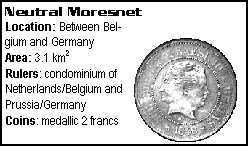 The Territory of Neutral Moresnet arose from the Congress of Vienna in 1815, when the Netherlands and Prussia could not agree as to who would own a zinc mine on their new border. Their solution: declaring a 3.1 km2 wedge-shaped enclave containing the mine site neutral, to be governed by commissioners appointed by the two powers and a mayor elected by the local populace. When Belgium seceded from the Netherlands it took over the Dutch interests in the territory. The unofficial coins, dated 1848, are of uncertain origin and show an interesting (and rather unflattering) janiform portrait of kings Frederick-Wilhelm IV of Prussia and Leopold I of Belgium. Despite lobbying by some locals and others to allow Moresnet to become an Esperanto-speaking independent country, the Treaty of Versailles gave the tiny territory to Belgium after World War I.
The Territory of Neutral Moresnet arose from the Congress of Vienna in 1815, when the Netherlands and Prussia could not agree as to who would own a zinc mine on their new border. Their solution: declaring a 3.1 km2 wedge-shaped enclave containing the mine site neutral, to be governed by commissioners appointed by the two powers and a mayor elected by the local populace. When Belgium seceded from the Netherlands it took over the Dutch interests in the territory. The unofficial coins, dated 1848, are of uncertain origin and show an interesting (and rather unflattering) janiform portrait of kings Frederick-Wilhelm IV of Prussia and Leopold I of Belgium. Despite lobbying by some locals and others to allow Moresnet to become an Esperanto-speaking independent country, the Treaty of Versailles gave the tiny territory to Belgium after World War I.
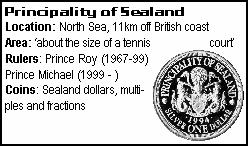 Sealand is a more recent British example of a secessionist ‘island’ and one which has made somewhat of a reputation for itself recently as a base for Internet anarchists wishing to escape increasingly vigilant government controls. The self – proclaimed principality’s ‘territory’ is an abandoned W.W.II gun tower out in the North Sea near the entrance to the English Channel which was, when independence was declared in 1967, outside British territorial waters.
Sealand is a more recent British example of a secessionist ‘island’ and one which has made somewhat of a reputation for itself recently as a base for Internet anarchists wishing to escape increasingly vigilant government controls. The self – proclaimed principality’s ‘territory’ is an abandoned W.W.II gun tower out in the North Sea near the entrance to the English Channel which was, when independence was declared in 1967, outside British territorial waters.
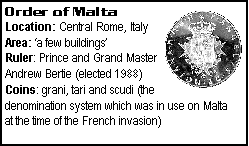 In Italy, a land which contains two formally recognised tiny countries entirely within its borders (San Marino and Vatican City), a third lurks, largely unrecognised: The Sovereign Military Order of Malta. These coins probably fall more under the category of ‘government-in-exile’ coins as, up until Napoleon evicted them from Malta in 1791, the knights actually did control lands in the Mediterranean. It is the most-recognised ‘nation’ in this article, with 90 nations having exchanged ambassadors. It also has been granted Permanent Observer status at the UN, largely through it’s humanitarian arm, similar to the Red Cross.
In Italy, a land which contains two formally recognised tiny countries entirely within its borders (San Marino and Vatican City), a third lurks, largely unrecognised: The Sovereign Military Order of Malta. These coins probably fall more under the category of ‘government-in-exile’ coins as, up until Napoleon evicted them from Malta in 1791, the knights actually did control lands in the Mediterranean. It is the most-recognised ‘nation’ in this article, with 90 nations having exchanged ambassadors. It also has been granted Permanent Observer status at the UN, largely through it’s humanitarian arm, similar to the Red Cross.
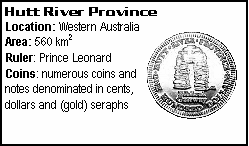 Here in Australia the most famous DCC issuer is the Hutt River Province Principality, a property in Western Australia which ‘seceded’ from Australia in 1970 to avoid unreasonable government wheat quotas and has since made a thriving business out of selling stamps, coins, passports, licence plates and knighthoods.
Here in Australia the most famous DCC issuer is the Hutt River Province Principality, a property in Western Australia which ‘seceded’ from Australia in 1970 to avoid unreasonable government wheat quotas and has since made a thriving business out of selling stamps, coins, passports, licence plates and knighthoods.
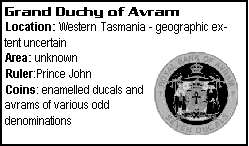 But Hutt River Province is not the only DCC issuer in Australia. It’s Tasmanian counterpart is the Grand Duchy of Avram. Prince John, the subject of an article in Issue #4 of the QNS Magazine, is still going strong. However, I have tried, and failed, to determine exactly where the ‘duchy’ is; It seems to be more a philosophy than an actual place. Still, he may not have lands, but he does have coins. The coins are brightly coloured, come in several peculiar denominations such as 7 and 15 ducals and feature heraldic designs which appear to be Masonic in character.
But Hutt River Province is not the only DCC issuer in Australia. It’s Tasmanian counterpart is the Grand Duchy of Avram. Prince John, the subject of an article in Issue #4 of the QNS Magazine, is still going strong. However, I have tried, and failed, to determine exactly where the ‘duchy’ is; It seems to be more a philosophy than an actual place. Still, he may not have lands, but he does have coins. The coins are brightly coloured, come in several peculiar denominations such as 7 and 15 ducals and feature heraldic designs which appear to be Masonic in character.
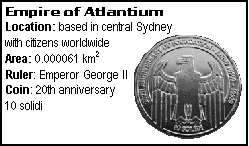 The Empire of Atlantium is the newest pseudo-nation in Australia to issue a coin. This group of “one-world-government” activists boasts that their ‘nation’ is the next stage in social evolution and claims ‘citizens’ in dozens of countries. Atlantium’s only ‘territory’ is it’s Sydney HQ. As I was preparing this article, coincidentally (honest!), CAB Magazine ran an article on this coin issue.
The Empire of Atlantium is the newest pseudo-nation in Australia to issue a coin. This group of “one-world-government” activists boasts that their ‘nation’ is the next stage in social evolution and claims ‘citizens’ in dozens of countries. Atlantium’s only ‘territory’ is it’s Sydney HQ. As I was preparing this article, coincidentally (honest!), CAB Magazine ran an article on this coin issue.
The Internet is filled with groups such as this, known as ‘virtual states’ or ‘micronations’, whose existence is almost wholly Internet-based. The Google directory currently lists some 100-odd worldwide, under “Society-Issues-Secession-Micronations”. Many of them seem to be fronts for fringe religious and philosophical groups.
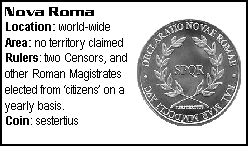 One such is Nova Roma, a group claiming to be “an organization dedicated to the study and restoration of ancient Roman culture”, including Republican government, customs and religion. They have just released their first coin, a “sestertius signum” tariffed at, and sold for, US50¢ (which is quite cheap for DCC).
One such is Nova Roma, a group claiming to be “an organization dedicated to the study and restoration of ancient Roman culture”, including Republican government, customs and religion. They have just released their first coin, a “sestertius signum” tariffed at, and sold for, US50¢ (which is quite cheap for DCC).
REFERENCES
Std Cat World Coins
Australasian Coin & Banknote magazine, July 2002 p. 46
New Scientist article, “In Rebel Territory”, 22 June 2002
WEBSITES
www.sealandgov.org
www.grandduchy.org
www.atlantium.org/faq.html
www.hutt-river-province.com/
www.orderofmalta.int
www.novaroma.org/main.html
This article first appeared in the August 2002 Magazine.
